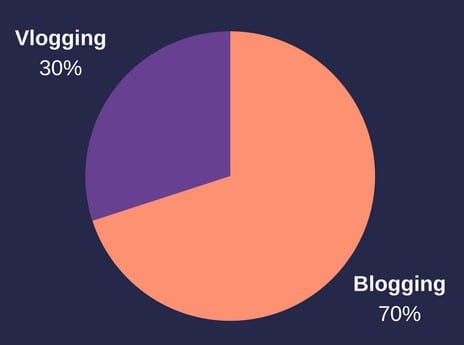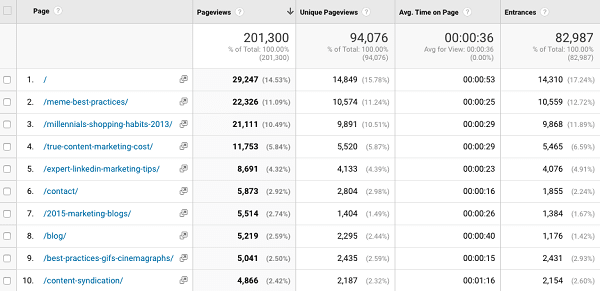Boost your brand’s search rankings while reaching your audience by using both blogging and vlogging as part of your content strategy.
There’s lots of buzz today about how video is the “prime format” of content to invest in now and for the future. Though certainly true, think of it as just one part of a larger strategy.
With one-third of all online activity spent watching video and four times as many consumers preferring to watch a video about a product than reading about it, it’s clear that video is widely adopted.

From a business perspective, videos included in a company’s marketing can grow revenue 49 percent faster year-over-year than those that don’t. This is one of the many reasons vlogging, the practice of regularly sharing videos with your audience, has skyrocketed in popularity.
To see the most success with vlogging, especially at first, integrate the process with your company’s existing blogging strategy. Here’s how to use both content mediums together consistently to achieve your goals, while being mindful of your time and resources.
Why Integration Matters
The effectiveness of video aside, creating, editing, and publishing video regularly is a complicated and resource intensive task for marketers at all skill levels.
In fact, 43 percent of marketers said they’d create more video content if there were no obstacles like time and resource limitations.
At the same time, most companies have already invested in blogging since it’s highly effective at getting them discovered in search and social and above all, provides value to their customers.
Many businesses think they’re checking off the content marketing box by just relying on blogging alone. In reality, written content is an effective foundation that should be added to drive continued, worthwhile results that impact a company’s bottom line.
“We know video is ‘big’ right now, but it isn’t everything,” says Amy Schmittauer, vlogger, keynote speaker, and author of Vlog Like a Boss. “A company with a consistent blogging effort as their baseline content marketing has an advantage over others who are starting with vlogging.”
Instead of taking on vlogging as its own venture, equal in scale to what you’re doing with blogging, integrate both your blogging and vlogging efforts together.

This approach allows you to save and consolidate your resources, get more insight into what topics resonate, increase the discoverability of your content, and earn more benefits from each piece of content you’re publishing.
One Medium Should Inform the Other
As a starting point, use what you’ve done to date with blogging to inform where you’ll begin with vlogging. Review your analytics to identify your top performing blog posts in terms of the amount of traffic, engagement, and conversions they drove.
This way when you’re trying to decide what videos to create, consider producing videos on the topics from the blog that have already performed well with your audience.

By referencing your existing data to find the best topics, you’re increasing the likelihood that your videos will resonate too.
“Leveraging and repurposing that copy that’s shaped an effective marketing strategy and turning those ideas into video form will increase opportunities for discovery significantly,” says Amy Schmittauer.
“Videos — whether embedded on a webpage or simply uploaded to YouTube — stand a [better] chance than a text page does for hitting the front page of Google.”
This approach increases the likelihood of your content being discovered in search when your videos are optimized properly, but also saves valuable time and resources since you’ve already created content on this subject before.
The process can work both ways, too, as any video that drives results for your organization can be explored further as a blog post as well.
Choosing the Video Style
With the right topics in mind, the blog posts that have already done well can act as a script for the videos you’ll create.
It isn’t necessary to include every word from your blog post in the video version, but instead use the blog post as a reference for the general subject area to focus on.
You’re not reinventing the wheel or starting from scratch here, which puts your organization one step ahead of the curve.
There are many types of videos your team could create based off your blog posts, but here are some top options to consider:
- Tutorials or how-to: Showcase the best ways to act on the recommendations included in the article. Here’s an example of this type of video from Canva.
- Interviews: Host a discussion with members of your team, a client, or an expert source to review a topic from their perspective. Here’s an example of this type of video from Red Bull.
- Audio: Similar to a podcast, create an audio version of an article by reading it word-for-word. Consider including visuals like dynamic graphics that illustrate what’s being said or a static image with minimal movement. Here’s an example of this type of video from Tim Ferriss.
- Case study: Describe the story behind a client or customer’s use of your products or services as it relates to the focus of a related blog post. Here’s an example of this type of video from MailChimp.
- Promotional: Showcase your products or services in action by emphasizing the value they provide or how they differ from others. Here’s an example of this type of video from
- User-generated: Curate footage provided by customers on social media or from elsewhere about your organization and its products. Here’s an example of this type of video from Taco Bell.
- Previously recorded content: Upload video content that’s already been recorded from a different channel like a live stream on social media or a webinar. Here’s an example of this type of video from iChess.net.
While the focus of your videos should be driven by the subjects of your top performing blog posts, ensure each video can stand alone and still make sense without the additional context the original blog post provides.
Embed to Spur Cross-Promotion
Once a video has been filmed and edited, publish the vlog on YouTube and then embed it within your blog posts to increase the discoverability of your content.
“I think the best way to build a framework for integrating blogging and vlogging is to focus on cross-promoting content so that you’re essentially repurposing two pieces at once,” says Brittany Berger, head of content and PR at Mention.
Each video and blog post should exist as a distinct piece of content, discoverable on its own in search, but still complementary when viewed together as a blog post with a video included.
Berger explains that by embedding each video within the blog post, you’re providing additional information for readers, but also driving traffic to your website instead of YouTube.
When promoting your videos, share a link to the blog post where the videos have been embedded as opposed to a link to the video on YouTube. You want to drive your audience to your own website, not a third-party site.

If your videos are found on YouTube or Google, then that’s useful for reaching a wider audience, but your own promotion of these videos needs to be more strategic and focused on your owned properties. Building links to your YouTube channel doesn’t help your website’s SEO.
In addition, the content from other companies is also featured on YouTube and Google, which can distract users from your content. This is another reason why driving traffic to your website is more ideal since you’re in control of the experience visitors have there.
Ideally, this approach will help your organization attract more links to your blog articles as well, since these blog posts provide useful information in multiple formats.
Challenges to Consider
As your organization integrates vlogging and blogging, ensure you’re consistently publishing, branding in a cohesive manner, and executing on your schedule to see continued results,” says Emily Richett, founder and lead publicist of Richett Media, a hybrid PR and marketing agency.
Consistency: Focusing on a clear cadence for your blogging and vlogging efforts helps establish a habit with your customers. “Your audience needs to count on a set schedule where they know you’ll be delivering high-value content,” Richett says.
“One of the most difficult tasks to creating successful blogs and vlogs is creating a strategic, long-term plan,” she said. “Six months is an ideal timeframe for creating a content calendar as it’s far enough out to plan ahead and be thoughtful with your strategy. It lets you plan far enough ahead to build in concrete calls-to-action and to make your content timely, but not too far down the road that you can’t easily shift course if needed.”

When first adding vlogging to your content mix, start small by publishing one to three videos per month to understand what’s needed to develop a video from start to finish.
This way, your team can make a more informed decision as to what publishing cadence you’ll realistically be able to commit to after completing the work.
Cohesive branding: This is where a concrete content strategy comes into play to map out your branding approach across two different formats of content to ensure a singular, uniform voice and perspective.
“Take the time to create a blog/vlog style guide that clearly identifies the tone and style of the content,” says Emily Richett. “Don’t forget to include specific style-guide references and consider establishing a key editor of your vlog or blog, if it has multiple contributors.
“This will help to ensure basic standards are being followed across the board. Utilize a project management system as well to keep all contributors on the same page and to streamline communications.” Richett recommends using Trello and Slack for a cohesive approach to content management.
To brand your videos effectively, be strategic about choices regarding the title of the video, thumbnail, the video’s description, and any graphics included throughout the video as each element is a reflection of your brand’s aesthetic.
The thumbnail and the title of the video are prominently shown as part of the embed within your company’s articles, which is important to keep in mind as well.
Execution: “On the flip side, all the planning in the world won’t be beneficial if you don’t eventually execute,” says Richett. “There is a vulnerability that goes along with content creation, especially vlogging. The brands that are willing to take the risk and put themselves out there will have a greater chance at reaping the rewards and connecting to a larger audience in the process.”
Putting your company’s ideas out there is a touchy venture as some pieces of content will fail to generate traction, while others will help your organization move closer to its goals.
In order to truly stand out by integrating both types of content, your team can’t be afraid to take risks with the topics covered.
Effective execution doesn’t mean putting just any video or blog content out, but instead means taking chances and covering topics that tie back to specific brand goals.
Foster a Human Connection, Regardless of the content_type
The concept of being vulnerable as an organization through your approach to blogging and vlogging is one of the most important concerns to address.
If done correctly, expressing a certain level of vulnerability in your blogs and videos makes it easier for viewers and readers to empathize with your company and its mission.
Whether you’re producing a blog post, a video, or both, the format needs to help humanize your brand to build a stronger connection with your audience.
“The reason why video is key to humanizing your brand is it can provide an opportunity to see the people behind the brand,” says Frank Eliason, author, keynote speaker, and partner at Brain+Trust Partners.
“By watching your videos, customers have the opportunity to see that the people behind the company are just like them and better understand what you stand for as a partner.
“People have become more connected with the rise of social media, but in many ways, more disconnected too. On a personal level, it’s more likely for consumers to be active in tight knit circles of people that think the same way they do and this has a direct impact on brands too,” adds Eliason.
Consumers have fewer reasons today to interact with brands. “We utilize the web to answer most of our questions, in an almost robotic-like manner,” he says. “If we are unable to find the answer that way, we ask our trusted resources within our pool of friends.”
Video can change this paradigm since questions can be answered in a more thorough manner and take us out of a robotic state.

With the addition of humor or another touch from within, the culture of the company can take a customer from being indifferent or harboring negative feelings toward a brand, to a state of loving the brand.
This is a prime example of establishing a human connection. “The world will continue to get more robotic, but if we can find ways to build that human connection we can build relationships for life,” says Eliason. “Successful businesses will realize this and create video that helps their customer win, and in turn, helps them win.”
As you’re choosing blog posts to expand into videos or vice versa, think back to your company’s distinct personality and perspective. Add humanizing elements to the content you’re creating, whether that’s inserting humor, explaining why your organization exists in the first place, the causes and issues the brand stands by, featuring your staff’s experiences, and more.
What roadblocks have your organization faced creating video in the past? Has your brand repurposed blog posts into other formats of content previously? Let us know if you’ve seen success with integrating blogging and vlogging by tweeting us over on Twitter @DigitalCurrent.


